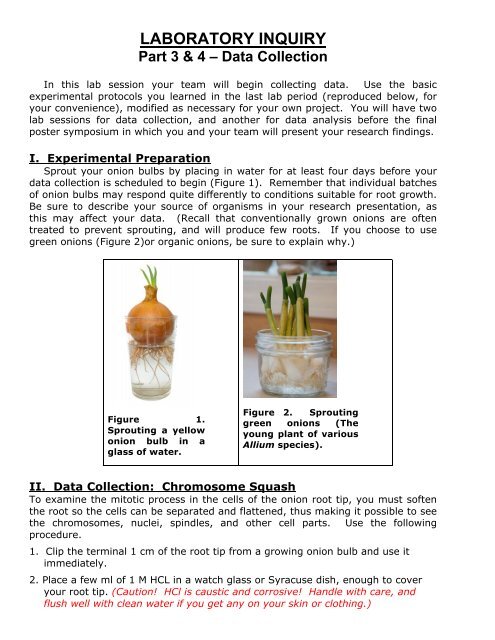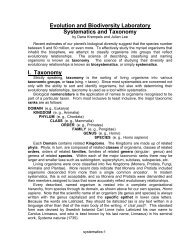Mechanisms of Mitosis: Data Collection
Mechanisms of Mitosis: Data Collection
Mechanisms of Mitosis: Data Collection
You also want an ePaper? Increase the reach of your titles
YUMPU automatically turns print PDFs into web optimized ePapers that Google loves.
LABORATORY INQUIRYPart 3 & 4 – <strong>Data</strong> <strong>Collection</strong>In this lab session your team will begin collecting data. Use the basicexperimental protocols you learned in the last lab period (reproduced below, foryour convenience), modified as necessary for your own project. You will have twolab sessions for data collection, and another for data analysis before the finalposter symposium in which you and your team will present your research findings.I. Experimental PreparationSprout your onion bulbs by placing in water for at least four days before yourdata collection is scheduled to begin (Figure 1). Remember that individual batches<strong>of</strong> onion bulbs may respond quite differently to conditions suitable for root growth.Be sure to describe your source <strong>of</strong> organisms in your research presentation, asthis may affect your data. (Recall that conventionally grown onions are <strong>of</strong>tentreated to prevent sprouting, and will produce few roots. If you choose to usegreen onions (Figure 2)or organic onions, be sure to explain why.)Figure 1.Sprouting a yellowonion bulb in aglass <strong>of</strong> water.Figure 2. Sproutinggreen onions (Theyoung plant <strong>of</strong> variousAllium species).II. <strong>Data</strong> <strong>Collection</strong>: Chromosome SquashTo examine the mitotic process in the cells <strong>of</strong> the onion root tip, you must s<strong>of</strong>tenthe root so the cells can be separated and flattened, thus making it possible to seethe chromosomes, nuclei, spindles, and other cell parts. Use the followingprocedure.1. Clip the terminal 1 cm <strong>of</strong> the root tip from a growing onion bulb and use itimmediately.2. Place a few ml <strong>of</strong> 1 M HCL in a watch glass or Syracuse dish, enough to coveryour root tip. (Caution! HCl is caustic and corrosive! Handle with care, andflush well with clean water if you get any on your skin or clothing.)
2. Into this acid place the terminal 3 or 4 mm <strong>of</strong> the 1-cm-long onion root.3. In a short time (a few minutes) the root tip will feel s<strong>of</strong>t when touched with adissecting needle.4. Now, using forceps or a needle, pick up the s<strong>of</strong>tened root tip and transfer it to adrop <strong>of</strong> acetocarmine stain on a clean slide.5. Using a razor blade or a sharp scalpel, chop the root tip into tiny pieces. Note:Iron in the scalpel or dissecting needle reacts with the acetocarmine stain(Caution! Acetocarmine is caustic and corrosive! Handle with care, and flushwell with clean water if you get any on your skin or clothing. Acetocarminemay stain skin and permanently stain clothing.), to give a better stainingreaction.6. Once this procedure is complete, apply a clean cover glass to the slide and heatit gently over an alcohol lamp or slide warmer. Do not boil! Then invert theslide on a paper towel and push downward firmly, applying pressure with yourthumb over the cover glass. This should flatten the cells and disperse them sothey can be observed under the microscope.7. Examine under lower power (100x) and then under high power (400x).8. Use the same procedure to examine your treatment and control roots.9. Count the number <strong>of</strong> cells you can identify in each stage <strong>of</strong> mitosis. Use thesedata for statistical analysis, to determine whether there is a statisticallysignificant difference between your treatment and control samples.10. For comparison, you may wish to examine a commercially prepared slide <strong>of</strong>an onion root tip (available from your instructor). Observe the slide using lowand high power.NOTE: If you wish to preserve samples for later analysis, you will need topreserve them in Caroy’s solution: 6 parts absolute ethyl alcohol: 3 partschlor<strong>of</strong>orm: 1 part glacial acetic acid. Place the root tip in Caroy’s solution for 24hours and then store in 70% ethyl alcohol until the time <strong>of</strong> use.Every team member should keep a copy <strong>of</strong> the team’s entire raw data set,and will be responsible for understanding and cooperating in the analysis<strong>of</strong> the data in the penultimate lab session.
















